View in other NatureServe Network Field Guides
NatureServe
Montana
Utah
Wyoming
Idaho
Wisconsin
British Columbia
South Carolina
Yukon
California
New York
Shiny Tightcoil - Pristiloma wascoense
Other Names:
Tonites wascoense, Polita chersinella
General Description
A small shell, to about 3.0 mm diameter and 1.5 mm in height, depressed heliciform, with up to 5 whorls. Shell is transparent amber brown, smooth (until seen under magnification) and shiny, appearing darker brown when the animal is alive. Aperture is crescent-shaped, umbilicus is narrow and deep. The body and tentacles are dark (Hendricks 2012, Burke 2013).
Diagnostic Characteristics
Very small size and brown color separates Pristiloma from other shells except the spots (Punctum and Paralaoma); Pristiloma is slightly larger with more whorls, a narrow or absent umbilicus, and lacks riblets. Pristiloma wascoense differs from P. idahoense, the only other Pristiloma documented in Montana, by the presence of an open umbilicus (shell is perforate), absence of a shoulder on the body whorl, fewer whorls, and slightly smaller size.
Species Range
Montana Range
Range Descriptions

 Native
Native
Range Comments
Washington and Oregon east through western Montana. In Montana, 20 records from seven counties west or near the Continental Divide: Deer Lodge (1), Flathead (6), Glacier (6), Granite (2), Lake (1), Lincoln (1), Mineral (3). Elevation range is 1152 to 2582 m (3780 to 8470 ft). The earliest Montana specimens from Glacier National Park were reported in 1916 and originally assigned to Pristiloma chersinella. No other member of the genus has been documented in Montana, where the range remains poorly defined. Up to six live animals were reported at one site in Deer Lodge County in late July (Hendricks 2012).
Observations in Montana Natural Heritage Program Database
Number of Observations: 22
(Click on the following maps and charts to see full sized version)
Map Help and Descriptions
Relative Density
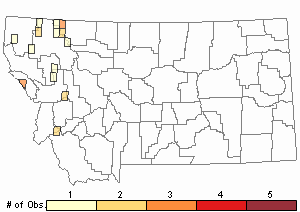
Recency
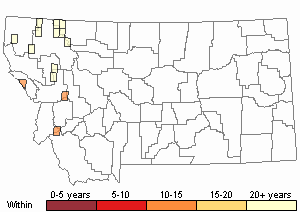
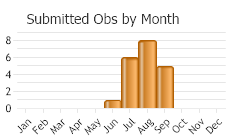
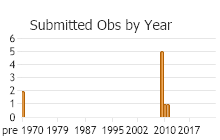
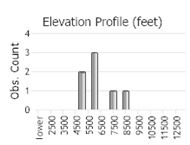 (Observations spanning multiple months or years are excluded from time charts)
(Observations spanning multiple months or years are excluded from time charts)
Habitat
Mesic mixed conifer forest. Canopy species include Engelmann spruce, subalpine fir, whitebark pine and lodgepole pine, with a secondary canopy including alder. Found under woody debris and rocks, in leaf and needle litter and duff (Hendricks 2012).
Stewardship Responsibility
References
- Literature Cited AboveLegend:
 View Online Publication
View Online Publication Burke, T. E. 2013. Land snails and slugs of the Pacific Northwest. Corvallis, OR: Oregon State University Press. 344 p.
Burke, T. E. 2013. Land snails and slugs of the Pacific Northwest. Corvallis, OR: Oregon State University Press. 344 p. Hendricks, P. 2012. A Guide to the Land Snails and Slugs of Montana. A report to the U.S. Forest Service - Region 1. Montana Natural Heritage Program, Helena, MT. vii + 187 pp. plus appendices.
Hendricks, P. 2012. A Guide to the Land Snails and Slugs of Montana. A report to the U.S. Forest Service - Region 1. Montana Natural Heritage Program, Helena, MT. vii + 187 pp. plus appendices.
- Additional ReferencesLegend:
 View Online Publication
View Online Publication
Do you know of a citation we're missing? Baker, H.B. 1930. New and problematic west American land snails. The Nautilus 43:121-128.
Baker, H.B. 1930. New and problematic west American land snails. The Nautilus 43:121-128. Berry, S.S. 1919. Mollusca of Glacier National Park, Montana. Proceedings of the Academy of Natural Sciences of Philadelphia 71:195-205.
Berry, S.S. 1919. Mollusca of Glacier National Park, Montana. Proceedings of the Academy of Natural Sciences of Philadelphia 71:195-205. Frest, T.J. and E.J. Johannes. 1995. Interior Columbia Basin mollusk species of special concern. Final report to the Interior Columbia Basin Ecosystem Management Project, Walla Walla, WA. Contract #43-0E00-4-9112. 274 pp. plus appendices.
Frest, T.J. and E.J. Johannes. 1995. Interior Columbia Basin mollusk species of special concern. Final report to the Interior Columbia Basin Ecosystem Management Project, Walla Walla, WA. Contract #43-0E00-4-9112. 274 pp. plus appendices. Frest, T.J. and E.J. Johannes. 2001. An annotated checklist of Idaho land and freshwater mollusks. Journal of the Idaho Academy of Science 36(2):1-51.
Frest, T.J. and E.J. Johannes. 2001. An annotated checklist of Idaho land and freshwater mollusks. Journal of the Idaho Academy of Science 36(2):1-51. Henderson, J. 1936. Mollusca of Colorado, Utah, Montana, Idaho, and Wyoming, supplement. University of Colorado Studies 23(2): 81-145.
Henderson, J. 1936. Mollusca of Colorado, Utah, Montana, Idaho, and Wyoming, supplement. University of Colorado Studies 23(2): 81-145. Pilsbry, H.A. 1946. Land Mollusca of North America (north of Mexico), Volume II Part 1. Academy of Natural Sciences of Philadelphia Monograph Number 3 (2):1-520.
Pilsbry, H.A. 1946. Land Mollusca of North America (north of Mexico), Volume II Part 1. Academy of Natural Sciences of Philadelphia Monograph Number 3 (2):1-520. Russell, R.H. and R.B. Brunson. 1967. A check-list of molluscs of Glacier National Park, Montana. Sterkiana 26:1-5.
Russell, R.H. and R.B. Brunson. 1967. A check-list of molluscs of Glacier National Park, Montana. Sterkiana 26:1-5.
- Web Search Engines for Articles on "Shiny Tightcoil"
- Additional Sources of Information Related to "Snails / Slugs"





